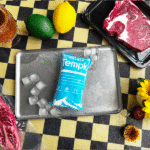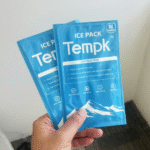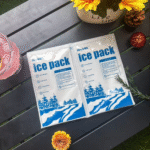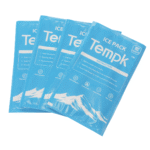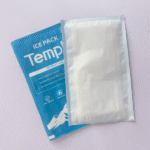المعنى اللوجستي لسلسلة التبريد: تعريف & 2025 الاتجاهات
تحديث: نوفمبر 18 2025
Cold chain logistics meaning refers to more than just shipping goods; it encompasses the complete management of temperature controlled supply chains from production to consumption. بعبارات بسيطة, you’re dealing with a system that keeps perishable products—like fresh foods, medications and vaccines—within strict temperature limits so they stay safe and effective. Market research shows the global cold chain logistics market is booming: a recent report estimated the market at دولار أمريكي 436.30 مليار في 2025, with projections reaching دولار أمريكي 1,359.78 مليار من قبل 2034. With such explosive growth, understanding what cold chain logistics truly means and how to manage it is critical for your business success.
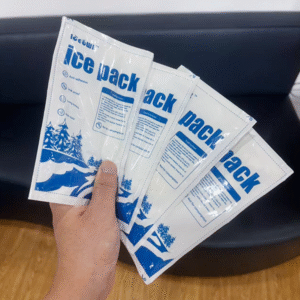
What does cold chain logistics mean in practice? We’ll break down the definition, components and common misconceptions.
Why is cold chain logistics important for your products and customers? We discuss safety, quality and compliance benefits with relatable examples.
What challenges do you face and how can you overcome them? Learn about infrastructure, regulatory and operational hurdles and actionable solutions.
أيّ 2025 trends should you watch? From digital twins and IoT sensors to sustainable refrigerants, we explore innovations and market data.
How to apply this knowledge to your business? نصائح عملية, self assessment questions and an action plan help you start improving your cold chain today.
What Does Cold Chain Logistics Really Mean?
Cold chain logistics means managing temperature for perishable products throughout the entire supply chain—from production through storage, transport and delivery—to preserve quality and safety. Unlike general logistics, which primarily focuses on moving goods from one place to another, cold chain logistics involves maintaining precise temperature ranges at every step. It’s a coordinated system of equipment, processes and people working together so that products like vaccines, dairy or seafood reach you in the same safe state they left the manufacturer.
Why the Definition Matters
Many people equate “cold chain logistics” with simply shipping refrigerated goods, but the meaning goes deeper. ال التحالف العالمي لسلسلة التبريد (دول مجلس التعاون الخليجي) defines the cold chain as “the management of temperature for perishable products to maintain quality and safety from the point of origin through the distribution chain to the final consumer”. بعبارة أخرى, it’s about يتحكم—controlling the environment around your goods and controlling the processes and people who handle them. When you view cold chain logistics through this lens, you understand that packaging, مرافق التخزين, transportation modes and monitoring systems all play equally important roles in protecting product integrity.
Cold Chain vs. Regular Supply Chain
| وجه | Regular Supply Chain | لوجستيات السلسلة الباردة | ماذا يعني لك |
| حساسية المنتج | Handles mostly non perishable goods like electronics or clothing. | Handles perishable goods that degrade if temperature fluctuates. | Your goods require tighter control and specialized handling to avoid spoilage or loss of efficacy. |
| التحكم في درجة الحرارة | Little to no temperature regulation. | Requires continuous temperature monitoring and control across storage and transit. | You must invest in refrigeration equipment and monitoring devices to meet regulatory requirements. |
| Regulatory oversight | Fewer industry specific regulations. | Subject to food safety laws, pharmaceutical good distribution practices and vaccine storage guidelines. | Compliance protects your brand and prevents costly recalls. |
| معدات | Standard warehouses, trucks and packaging. | Specialized cold rooms, reefer trucks, insulated packaging and IoT sensors. | Choosing the right equipment ensures product quality and reduces waste. |
Key Elements of an Effective Cold Chain
Every effective cold chain has several interrelated components. Understanding each part helps you design systems that protect your products and minimize risk.
Temperature Controlled Packaging
Keeping products at the right temperature starts with the packaging. Specialized insulation materials like water blankets, حزم هلام, phase change materials and insulated pouches absorb or release heat to maintain stable conditions during transit. Thermal containers—such as polystyrene coolers, insulated pallet liners and plant based shippers—provide an additional barrier against external temperature fluctuations. The right packaging depends on your product’s temperature range, shipment size and transit duration.
Cold Storage Facilities and Warehouses
Storage facilities are the backbone of cold chain logistics because products often sit in warehouses longer than they travel. Modern cold storage warehouses feature sophisticated refrigeration systems, floor to ceiling insulation, humidity control and real time temperature monitoring. These features ensure a consistent environment so your goods maintain their integrity. على سبيل المثال, refrigerated warehouses maintain chilled ranges of 2 درجة مئوية إلى 8 درجة مئوية for medications and some foods, while deep frozen rooms operate below -25 درجة مئوية for ice cream and seafood.
Cold Transport
After storage comes transport. شاحنات مبردة, عربات السكك الحديدية, reefer ships and airplanes move perishable goods while preserving temperature. These vehicles are equipped with onboard refrigeration units and often connected to telematics systems for real time temperature and location monitoring. Transport also includes handling processes such as pre cooling (removing heat before loading) and cross docking (transferring goods between vehicles without warehousing) to minimize temperature fluctuations.
مراقبة درجة الحرارة والتحكم
No cold chain can function without proper monitoring. ال CDC’s vaccine cold chain guidelines emphasize that all vaccines must be kept between 2 درجة مئوية و 8 درجة مئوية to remain potent and safe; even a single freezing event renders them useless. لضمان الامتثال, facilities deploy sensors and data loggers inside storage units and shipping containers. Real time alerts allow you to respond quickly if temperatures drift out of range, preventing product spoilage and protecting public health.
Quality Control and Compliance
Quality control measures such as تحليل المخاطر ونقاط التحكم الحرجة (تحليل المخاطر ونقاط المراقبة الحرجة) و ممارسات التوزيع الجيدة (الناتج المحلي الإجمالي) help identify risks and establish standard operating procedures for handling perishable goods. Regular audits, staff training and documentation ensure your processes align with food safety regulations (like the U.S. قانون تحديث سلامة الأغذية) and pharmaceutical standards. Compliance not only avoids penalties but also builds trust with customers who depend on safe products.
برنامج إدارة السلسلة الباردة
في السنوات الأخيرة, specialized software platforms have emerged to help manage complex cold chains. These tools integrate temperature sensor data, inventory systems and transport management into one dashboard. They support التحليلات التنبؤية, route optimization and digital documentation, reducing errors and improving efficiency. By adopting a comprehensive software solution, you gain full visibility into your operations and make data driven decisions.
Why Cold Chain Logistics Is So Important
Preserving Product Quality and Reducing Waste
Failing to maintain the correct temperature can lead to textural degradation, تغير اللون, microbial growth and loss of potency. When vaccines are stored outside their allowable range, they lose potency and may become useless. For food products, temperature abuse causes spoilage and increases risk of foodborne illnesses. Maintaining a robust cold chain therefore minimizes waste, extends shelf life and preserves the value of your inventory.
Guaranteeing Compliance and Protecting Public Health
Regulators across the world impose strict guidelines on handling perishable goods. The CDC’s vaccine storage and handling toolkit requires continuous temperature monitoring and detailed procedures for routine and emergency scenarios. Food and beverage regulations, pharmaceutical GDP requirements and chemical safety rules all demand adherence to specific temperature ranges. By following these rules, you reduce liability, avoid recalls and ensure the safety of consumers.
Enhancing Customer Trust and Brand Loyalty
يتوقع المستهلكون أن تكون طازجة, safe products delivered on time. When you invest in cold chain logistics, you signal to your customers that you prioritize their well being. A strong cold chain helps maintain quality and helps you avoid negative headlines about spoiled goods, boosting your reputation.
Economic Impact and Market Growth
The cold chain industry drives massive economic activity. Research from أبحاث الأسبقية reports that the global cold chain logistics market size was دولار أمريكي 436.30 مليار في 2025 ومن المتوقع أن يصل دولار أمريكي 1,359.78 مليار من قبل 2034. ال Food Shippers of America notes similar momentum: وقد بلغت قيمة السوق أكثر من دولار أمريكي 321 مليار في 2023 ومن المتوقع أن يتجاوز دولار أمريكي 1,245 مليار من قبل 2033, مع 14.5 % CAGR. Such growth underscores the importance of maintaining a reliable cold chain to capitalize on expanding demand across food, pharmaceuticals and biotech sectors.
مثال الحالة: Vaccine Viability
Consider vaccine distribution. NIST research notes that most vaccines must be kept between 2 درجة مئوية و 8 درجة مئوية, and any exposure outside this range diminishes their potency. في الحقيقة, a meta analysis estimated that 35 % of the world’s vaccines are accidentally frozen during storage or transit, جعلهم غير فعال. By investing in purpose built refrigerators, calibrated sensors and staff training, healthcare providers have reduced wasted doses and improved public confidence. This example highlights how proper cold chain management directly impacts public health.
Challenges and Solutions in Cold Chain Logistics
Infrastructure and Aging Facilities
Many cold storage facilities were built decades ago and lack modern insulation, energy efficiency and automation. ميرسك points out that aging infrastructure pressures operators to upgrade equipment and replace harmful refrigerants. حل: invest in new refrigeration technology and eco friendly refrigerants, and retrofit warehouses with better insulation and humidity control. Explore government incentives for sustainable facility upgrades.
Visibility and Monitoring Gaps
Maintaining continuous visibility across multiple points in the supply chain is challenging. ميرسك highlights that 2025 will see continued investments in software to improve real time visibility so disruptions can be addressed quickly. حل: deploy IoT sensors and connect them to centralized platforms that provide alerts and analytics. Use digital twins to simulate operations and test changes before implementing them.
الامتثال التنظيمي
Compliance requires adhering to diverse standards such as ISO 9001, تحليل المخاطر ونقاط المراقبة الحرجة و ممارسات التوزيع الجيدة. Keeping up with evolving regulations—like the phase out of hydrofluorocarbons (مركبات الكربون الهيدروفلورية) and stricter FSMA requirements—can be overwhelming. حل: appoint a compliance coordinator, document Standard Operating Procedures (SOPS) and conduct regular audits. Use digital tools to track changes in regulations and generate automated compliance reports.
Energy Consumption and Sustainability
Refrigeration systems consume significant energy and contribute to greenhouse gas emissions. New regulations encourage environmentally friendly refrigerants and energy efficient designs. حل: adopt solar powered refrigeration units, variable speed compressors and thermal energy storage. Participate in programs like GCCA’s Energy Excellence Recognition Program, which helps warehouses measure and improve energy efficiency.
Complex Global Supply Chains
Cold chain logistics often spans multiple continents, involving air, sea and road transport. Disruptions such as pandemics, geopolitical tensions or extreme weather events can break links in the chain. حل: diversify suppliers, adopt near shoring strategies and maintain contingency plans. Invest in predictive analytics to anticipate disruptions and reroute shipments accordingly.
Skill Gaps and Training
Handling perishable goods requires specialized skills. Staff must understand how to package, حمولة, monitor and unload temperature sensitive shipments. حل: develop training programs and certifications for all employees involved in cold chain operations. Provide easy to follow SOPs and ensure each team member knows the consequences of temperature excursions.
Interactive Element: Cold Chain Self Assessment
To help you evaluate your cold chain readiness, try this quick Cold Chain Self Assessment:
Inventory Review – List all temperature sensitive products you handle. Note their required temperature ranges.
Equipment Audit – Inspect each refrigerator, freezer and refrigerated vehicle. Are they purpose built or household grade? (Remember that dorm style refrigerators are unsafe for vaccines.)
Monitoring Check – Confirm that each storage unit has calibrated sensors and that data is logged continuously. Identify any gaps in real time alerting.
Training Assessment – Verify that all employees handling perishable goods have up to date training and know your SOPs.
Emergency Plan – Review your plan for power failures, equipment malfunctions or weather disruptions. Are backup generators, alternative storage and transport options in place?
Use this assessment as a starting point to prioritize improvements. A downloadable checklist or interactive quiz can help engage your team and reduce errors.
Latest Cold Chain Trends in 2025
صناعة سلسلة التبريد تتطور بسرعة. Here’s what the experts and recent research say about trends shaping 2025:
Digital Twins and IoT Sensors
Digital twins—virtual replicas of physical processes—allow you to simulate, monitor and optimize operations before making changes in real life. Paired with IoT sensors embedded in vehicles, containers and pallets, these technologies offer real time data on location, درجة الحرارة والرطوبة. This total visibility reduces risk and enables proactive decision making, especially in highly regulated sectors like pharmaceuticals, food and chemicals.
الذكاء الاصطناعي والتحليلات التنبؤية
Artificial intelligence isn’t just automating processes—it’s predicting behavior. Machine learning algorithms anticipate demand, optimize routes and identify potential disruptions. على سبيل المثال, by forecasting the impact of a port strike, you can reroute shipments before delays occur. Predictive analytics also helps right size resources and reduce energy usage.
Stronger Visibility and Software Investments
مثل ميرسك ملحوظات, companies are investing in software platforms that provide continuous data for location tracking and temperature monitoring. These tools improve communication among partners and help meet tightening regulatory requirements.
تحديث البنية التحتية
Aging cold storage facilities are being upgraded. New investments focus on الأتمتة, sustainability and improved visibility. The move away from harmful refrigerants towards natural alternatives like ammonia and CO₂ reduces environmental impact and ensures compliance with new regulations.
Emerging Products and Plant Based Foods
The rise of plant based protein alternatives and specialty foods is changing supply chain dynamics. ميرسك reports that plant based foods could make up 7.7 % سوق البروتين العالمي من خلال 2030. These products often come from smaller companies with less logistics experience, so they seek partners capable of maintaining precise temperature controls.
Expanding Market and Investment
Multiple sources forecast strong growth. أبحاث الأسبقية projects a 13.46 % معدل نمو سنوي مركب من 2025 ل 2034, with market size rising from دولار أمريكي 436.30 مليار في 2025 إلى USD 1,359.78 مليار من قبل 2034. ال Food Shippers of America cites a similar trajectory, noting that the market could reach دولار أمريكي 1,245 مليار من قبل 2033. Asia Pacific is expected to grow at the highest CAGR of حول 14.3 %.
الاستدامة واللوجستيات الخضراء
Cold chain providers are adopting eco friendly practices such as التبريد بالطاقة الشمسية, reusable insulation materials و energy efficient warehouse designs. Regulations like the phase out of HydroFluoroCarbons (مركبات الكربون الهيدروفلورية) and HydroChloroFluoroCarbons (مركبات الكربون الهيدروكلورية فلورية) drive innovation in refrigerants. Participating in programs like the GCCA’s energy excellence initiative helps companies measure and improve energy usage.
Adaptability to Disruptions
Geopolitical tensions, extreme weather events and pandemics continue to disrupt supply chains. كلاهما Across Logistics و ميرسك stress the need for resilient and regionalized supply chains that can adapt quickly to shocks. Near shoring and diversified supplier networks are becoming key strategies.
Cold Chain Temperature Requirements & Product Categories
Different products require distinct temperature ranges. Understanding these categories helps you choose appropriate storage and transport solutions.
| نطاق درجة الحرارة | المنتجات النموذجية | ماذا يعني لك |
| مبردة: 2 درجة مئوية – 8 درجة مئوية | اللقاحات, المنتجات الطازجة, ألبان, لحمة. | You must maintain strict refrigeration; even brief excursions reduce vaccine potency. Use pharmaceutical grade refrigerators and insulated packaging. |
| المجمدة: –18 °C – –25 °C | Frozen foods like meat, المأكولات البحرية, بوظة. | Requires deep freeze equipment and vehicles with powerful refrigeration units. Ensure the supply chain remains unbroken during loading and unloading. |
| المجمدة العميقة: < -25 درجة مئوية | عينات بيولوجية, cryogenic materials, بعض المستحضرات الصيدلانية. | Specialized freezers or liquid nitrogen containers needed; monitor continuously to avoid thawing. |
| Ambient Controlled (8 °C–15 °C or 15 درجة مئوية – 25 درجة مئوية) | Certain fruits, المشروبات, المواد الكيميائية. | Moderately temperature controlled; often used for products sensitive to high heat rather than cold. |
نصائح عملية & نصيحة
Select the right packaging: choose gel packs or phase change materials appropriate for your product’s temperature range and transit time. على سبيل المثال, vaccines should never be shipped with dry ice because freezing damages them.
Invest in quality equipment: avoid dorm style refrigerators for vaccines and opt for purpose built units with calibrated sensors.
المراقبة بشكل مستمر: install IoT sensors in every storage unit and shipping container and use software to track and alert you to temperature deviations in real time.
تدريب فريقك: ensure everyone understands the consequences of temperature excursions and is familiar with SOPs.
Plan for emergencies: have backup power supplies, alternative storage and transport options, and procedures for handling equipment failures.
حالة العالم الحقيقي: In the wake of high vaccine wastage, NIST studied vaccine storage conditions and found that dorm style refrigerators caused rapid accidental freezing. After providers switched to purpose built refrigerators and installed calibrated monitoring devices, wastage dropped significantly and patient confidence improved.
رؤى السوق & Regional Trends
محركات النمو
توسيع تجارة الغذاء العالمية: increasing demand for perishable foods and changing consumer preferences are driving the rapid growth of the cold chain market.
E commerce and online grocery: the rise of online grocery shopping requires reliable cold chain logistics to deliver fresh and frozen products.
التقدم التكنولوجي: blockchain based traceability, IoT enabled temperature monitoring and innovative packaging improve transparency and reduce spoilage.
الأسواق الناشئة والتحضر: rising incomes and urbanization in emerging markets create demand for convenient, temperature controlled foods.
Tightening regulations: stricter regulations like the FSMA and global GDP guidelines push companies to upgrade systems and processes.
المعالم الإقليمية
آسيا والمحيط الهادئ: fastest growing region, projected to reach the largest market share by 2034 due to population growth and expanding middle class.
أمريكا الشمالية: major investments in modernizing cold storage and adopting sustainable technologies. The market will grow from دولار أمريكي 116.85 مليار في 2024 إلى USD 289.58 مليار من قبل 2030 (مصدر: [regional report—update when available]).
أوروبا: investing in larger, automated facilities and phasing out harmful refrigerants.
أمريكا اللاتينية: increasing investments in cold storage infrastructure and digital platforms to support fast growing food exports.
الأسئلة المتداولة
What is cold chain logistics meaning? Cold chain logistics refers to controlling and monitoring temperature throughout the supply chain for perishable products, keeping them within safe ranges from production to consumption.
How does cold chain logistics work? It combines specialized packaging, مرافق التخزين البارد, النقل المبرد, continuous temperature monitoring and strict quality control measures to maintain product quality and safety.
Why is temperature control critical in the cold chain? Exceeding the allowable temperature range can cause spoilage, contamination or loss of potency. للقاحات, even a single freezing event makes them useless.
What are the key challenges in cold chain logistics? Aging infrastructure, lack of visibility, الامتثال التنظيمي, high energy consumption, complex global networks and skills gaps are major challenges.
ما هي الاتجاهات التي تشكل الخدمات اللوجستية لسلسلة التبريد 2025? التوائم الرقمية, مستشعرات إنترنت الأشياء, التحليلات التنبؤية المدفوعة بالذكاء الاصطناعي, investments in software, modernization of facilities, rise of plant based foods and sustainability initiatives are key trends.
What temperature range should I use for vaccines? Vaccines must be stored between 2 درجة مئوية و 8 درجة مئوية and should never be frozen. Check manufacturer guidelines for specific vaccines.
How can I improve my cold chain quickly? Start with a self assessment: audit your inventory, equipment and monitoring systems, تدريب الموظفين, and implement an emergency plan. Prioritize investments in IoT sensors and purpose built refrigerators.
ملخص & التوصيات
Cold chain logistics meaning goes beyond transporting refrigerated goods. It’s a comprehensive system for managing temperature sensitive products from production to consumption. By understanding core components—packaging, تخزين, ينقل, monitoring and compliance—you can protect product quality, meet regulations and build trust. السوق ينمو بسرعة, with forecasts showing billions in growth and new opportunities. لكن, challenges like aging infrastructure, lack of visibility and regulatory complexity require strategic investments and training.
خطوات العمل:
قم بمراجعة سلسلة التبريد الحالية لديك: Use the self assessment checklist to identify gaps in equipment, monitoring and training.
Upgrade equipment and technology: Invest in purpose built refrigeration units, IoT sensors and software platforms for real time visibility.
تدريب فريقك: Ensure all staff understand SOPs and the importance of temperature control.
خطة للاستدامة: Retrofit facilities with energy efficient systems and adopt eco friendly refrigerants.
Stay informed about regulations and trends: Follow industry updates and incorporate new best practices to keep your cold chain competitive.
حول Tempk
Tempk is a leading provider of cold chain solutions. We specialize in designing and implementing temperature controlled storage and transport systems, integrating IoT sensors for real time monitoring and predictive analytics. Our team combines industry expertise with innovative technology to help you maintain product integrity, comply with regulations and reduce waste. We’re committed to sustainability and offer energy efficient refrigeration solutions and eco friendly packaging. With Tempk as your partner, you gain peace of mind knowing your perishable goods stay safe and your cold chain runs smoothly.
الخطوة التالية: على استعداد لتعزيز سلسلة التبريد الخاصة بك? Contact our experts to discuss your needs and start building a resilient, compliant and sustainable cold chain today
















